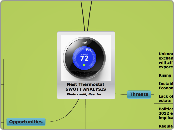
Nest Thermostat SWOTT ANALYSIS
Photo credit, Nest Inc.undefined
Weaknesses
Product line needs diversification, quickly
High overall unit cost in relation to other programmable thermostats available at Lowe's
Need to establish relationship with Home Depot
Current technology is limited to N. American marketplace
Marketing should be diversified beyond current demographics and expand to secondary targets
Competitors are developing similar applications and technologies
Honeywell lawsuit could compromise technology and capital
Threats
Unknown if foreign exchange rates and tariffs will affect imports or exports in future
Rising commodity prices
Instability of US and World Economies
Lack of confidence in real estate sector
Political uncertainty and 2012 election year implications
Regulations regarding labor, wages, taxation and privacy
Trends
Acknowledged importance of saving energy and monitoring savings
Consumers want mobile and immediate access to information
Demand for streamlined attractive design and new interactive technologies
Strengths
Product is unique and leading the market
Brand becoming more recognizable
Innovative technology and mobile, easy to use interface
Production is strong with minimal errors
Supply is meeting increasing demand
Volume can be easily scaled to meet increased commercial demand
Furthering North American market penetration
Developing new proprietary technology
Solid venture capital funding for continued innovation and growth
Positve company culture and employee relationships
Strong partnership with Lowe's retailer
Unique alliances with industry groups including utilities, tech, renewable energy, construction
Strong partnerships with academics, NGOS and environmental groups
Innovative marketing approaches using consumer research
Close to finalizing compatibility with HVAC systems in Europe and Asia
Able to expand product line; diversify into other emerging technologies, such as microinverters, refrigeration controls, etc
Opportunities
Pending regulatory environment and utility programs favoring WiFi enabled thermostats and demand management
Economic outlook for green building is improving
Green consumer base is growing
Cost of energy is increasing
Awareness of energy conservation and energy management is growing
Tech-savvy consumer base is growing
Consumer confidence is rising
Unemployment is decreasing
New technology is raising living standards in the US and is further driving economic growth
Baby boomers are retiring and purchasing second homes in hot climates
Consumers are purchasing fewer items overall and are focusing on high quality products when they shop
